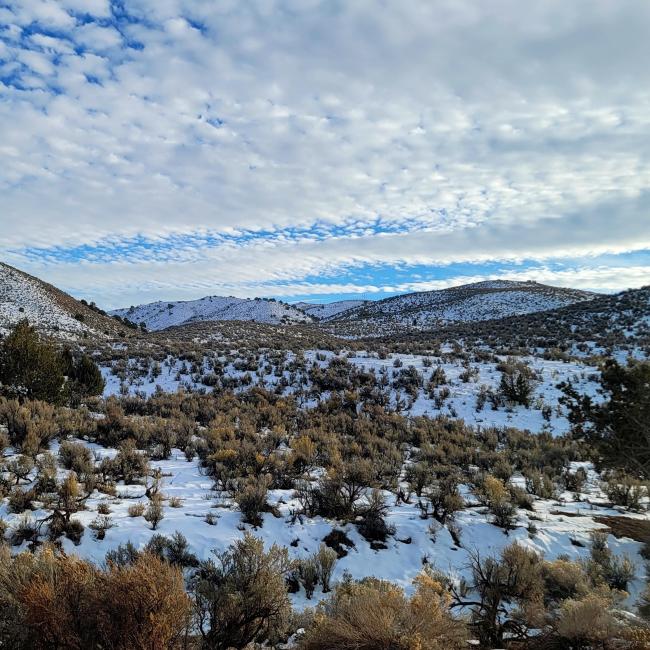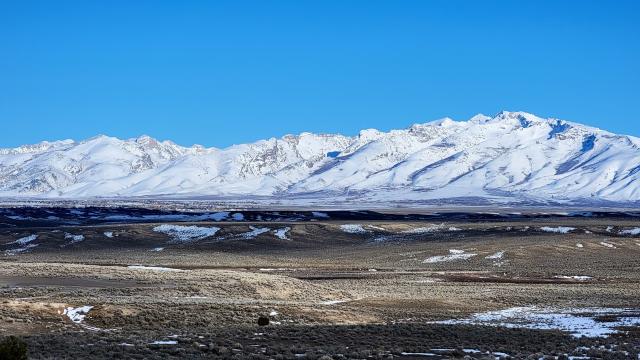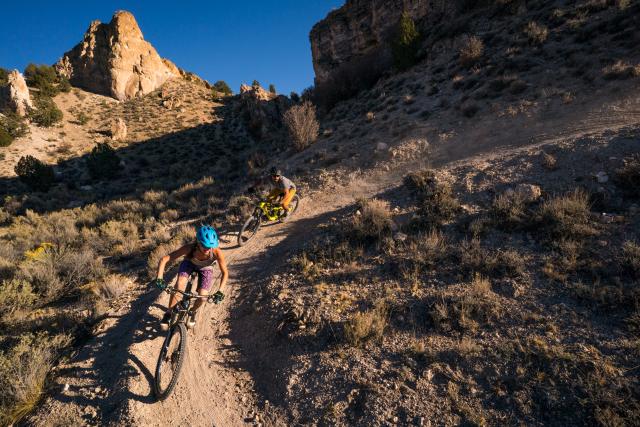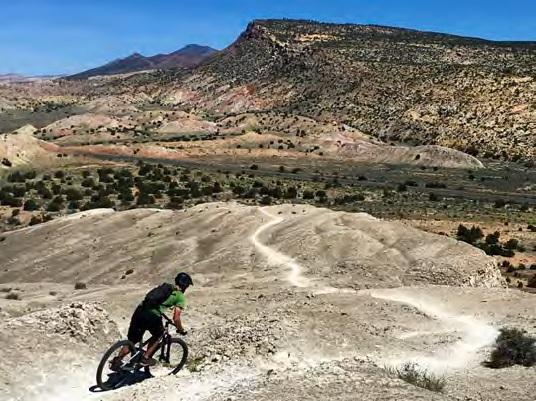Elko, Nevada residents rally to create new non-motorized trail system
Listen
Subscribe
Related Content
Between Elko and Spring Creek, Nevada, a group of residents and recreation enthusiasts from the Elko Trail Systems Initiative (ETSI) is working with BLM's Tuscarora Field Office to create a new non-motorized trail system. The group hopes that it will bring fun and business to local communities. When completed, the non-motorized trail will be open to hikers, horseback riding, and mountain biking, including e-bikes. Today, we visit with Elisabeth Puentes, Tuscarora Field Manager, about the planning efforts for this new trail system.
Transcript
DAVID HOWELL, BLM Communications: Near the town of Elko, NV, a group of residents have banded together to create a recreation opportunity they hope will bring fun and business for years to come. I'm David Howell, and you're listening to “On The Ground, a Bureau of Land Management Podcast.”
Last episode, we highlighted a trail near Cedar City, UT that has already seen a lot of development. This week I got a chance to talk with Elisabeth Puentes, BLM's Tuscarora Field Manager, who is really at the planning stage for a brand-new trail system on Lamoille Summit near Elko. As with many federal proposals, the planning stage includes examining environmental impacts as required by the National Environmental Policy Act, or NEPA. You'll hear her talk about NEPA at length, but what's interesting about this trail is the high level of positive community engagement and enthusiasm that's happening even before shovels dig into the dirt.
ELISABETH PUENTES, BLM Tuscarora Field Manager: Currently we have proposed about 50 miles of trail for non-motorized use, so hiking, biking, equestrian use and even in the winter, you know, snowshoeing. And it's right between Elko and the community of Spring Creek. So, I think it's a perfect location, right in the middle of both of the communities. There's other bike trail systems being planned outside of BLM lands, and hopefully in the future this is a connector to those trails in Spring Creek, to the trails in Elko, going out, all the way out to a community out in Carlin, Nevada. So, I think it's a great location where hopefully it will get a lot of use.
HOWELL: So is this trail, then, not really even fully developed? Then, this is something that you're kind of on the ground floor?
PUENTES: Correct! We are in the middle of NEPA for this. So, just last month we held our public scoping meetings - we held a virtual one and an in-person one. But we hope to have a decision by February and be able to get everything in place to construct to come next summer-fall time period.
HOWELL: Oh, this is exciting, then!
PUENTES: It is!
HOWELL: Yeah, I mean, we don't usually get an opportunity to talk about a trail that hasn't even been designed.
PUENTES: So, we do have an initial conceptual design that we had received BIL [Bipartisan Infrastructure Law] funding for in 2022. Those designs were completed last year, which then allowed us to kick off the NEPA process.
HOWELL: Well, that's awesome! Well, the tip that I got when I was talking with folks in the BLM in Nevada said that this is a project that has had a huge amount of community partnerships already. So maybe tell me a little bit about what partners are at the table and why they're there? What they're interested in?
PUENTES: It's called ETSI, and it's actually a group of partners that came together. It's made-up of Elko Velo, which is a local bike group, Elko County, the Northeastern Nevada Stewardship Group, and Nevada Outdoor Schools. A lot of support in our community for this bike trail, but if you really compare this project to the type of support and groups that you have coming together like, let's say, in Southern Nevada, then realistically we are… it's a tiny group of us together.
HOWELL: Tiny but mighty, I would imagine.
PUENTES: Yes, exactly. If you look at the type of support and groups that come together for other projects, I mean, you could have a couple lists of groups, right? And here, we're a small group, but we've gotten community support -- donations from, you know, even Nevada gold mines to help out with NEPA for this project. So like you said, small but mighty.
HOWELL: Well, that's fantastic. OK, so what does ETSI stand for? I know it's not the crafters website. Uh…
PUENTES: Oh, yes: Elko Trail Systems Initiative. They were strategic on putting this group together. Elko County, a couple of years ago, had actually completed a feasibility study. So back in 2022, Elko County completed this feasibility study, which showed that project like this would have a positive impact in the community. You know, we had Nevada Outdoor School, which is really set up...It's a nonprofit that was going to help us with the contracting for the NEPA.
HOWELL: Mmm, okay.
PUENTES: So we're very strategic on the groups that came together to form Elko Trail System Initiative. Leslie Creel has actually been the one leading the group, putting contracts together, reaching out to the community to those interested parties. And without her, to be honest, we wouldn't have been able to get this this project moving. She has been the one spearheading everything. It was thanks to ETSI and Leslie Creel putting in for grants that we were able to get the funding for NEPA, and without that, I mean, nothing else really would have mattered here.
HOWELL: OK, so what's the vision then that this group is talking about? You mentioned hiking trails and mountain biking trails -- so it's mostly… and equestrian. So it's so it's just completely non motorized.
PUENTES
Non motorized, although the exception for that would be Class 1 e-bikes.
HOWELL: Oh, okay!
PUENTES: The real… So this project has been in the works for over a decade now, and we just didn't have the partnership really coming together yet to see this through. But the big push was from the biking community. But when we started to have conversations, we wanted to make sure that in order to ensure that these trails got the use that we wanted them to have, and then be able to have future expansion on them that we included other users, such as hikers. We reached out to the equestrian users, you know, of the trails, and just as many non-motorized users that we could bring together to help support this project.
HOWELL: So as you said, you had a public comment period that you conducted back in August and I know it's maybe a little bit early, but is there anything you can tell us about, maybe, some of the feedback that you've gotten so far?
PUENTES: Yeah for the most part it is…it was very positive feedback, a lot of support. We even got support from motorized users saying that, you know, it was great that we were offering this opportunity out there, and in the future that they hope to work with us for trail systems for motorized use. So even support from those groups.
Overall, from the community, everybody's very supportive. You know, we did have some feedback from property owners adjacent to the project. You know, there's always concerns from those that will have the project near their property, or you know in their backyard, as they call it.
HOWELL: Yeah.
PUENTES: However, I think that use is still out there. There are some undeveloped trails out there that that bike users and hikers are already using, so we hope to be able to alleviate any concerns that local homeowners or property owners would have.
HOWELL: You know, that's a really good point because I think that especially for BLM, a lot of these trails that we developed first start out as somebody out on the landscape, you know, creating a trail with no thought about where it could go. And that's probably the case here as well?
PUENTES: A lot of these trails that are out there are like, like I said, undeveloped. Some of them are even like cattle trails that then, you know, people use for…
HOWELL: Oh right, yeah.
PUENTES: …for recreating, yeah, because we do have grazing still going out in that area and we'll continue to happen even after this trail system goes in. We don't plan to exclude grazing from the area or reduce any AUM's [animal unit-months], which was also a concern that was brought up during the public scoping period. So, there was a concern from some groups that we would reduce or exclude grazing, but that won't happen.
This project actually came to be because of an increase of unauthorized trails that we were seeing throughout, around the Elko community. It’s hard to tackle unauthorized trails, if then you don't offer the community a developed trail system that they could use in place of developing unauthorized trails, so that was a big push behind this, too -- is offering the community a place where they could go out and recreate.
HOWELL: Well, Elizabeth, it's been fantastic, and I wish all the best on this trail development. It's exciting to be on the ground floor of this project.
PUENTES: Yes, thank you, and we appreciate you wanting to highlight this project. And it's important for us to get it out into the community for two reasons: continued support in our road to get it constructed; also, so that when it's constructed, it really gets the use that we want to see on it. So, in the future there's potentially expansion, there's another recreation opportunity around this area, which includes state parks and state trail systems, so if we really get the use and support of this trail system in the future, you'll see connections into those other recreation opportunities.
HOWELL: Elisabeth Puentes is the field manager for BLM’s Tuscarora Field Office in Elko, Nevada. We should mention that the Tuscarora Field Office has received about $680,000 from the Inflation Reduction Act for the initial construction of the trailhead and parking area, which will be a good start to a multiyear project.
On our website for this episode, we will have information on the Elko Trail Systems Initiative, or ETSI, which includes a simulated flyover in Google Earth of the proposed trail system, as well as information about the partners.
And if you want to find a recreation opportunity on public lands near you, please visit BLM.gov/recreation.
I’m David Howell – Thanks for joining me! And we’ll see you out there, On The Ground.





